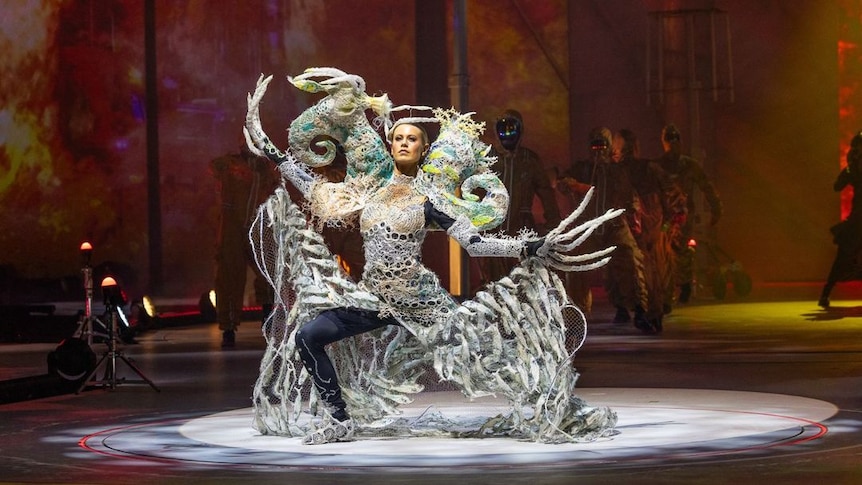When longtime friends Lynnette Griffiths and Marion Gaemers stroll along the beaches of Far North Queensland, they see beauty in the least expected places.
For more than 30 years, the artists have scoured shores far and wide, turning discarded ghost nets and marine debris into spectacular works of art while educating others.
“We don’t just make beautiful things, we really want to create the message of sustainability and [highlight] the problem of nets and ropes in the ocean and what’s happening on our beaches,” Griffiths said.
Griffiths and Gaemers have built a reputation for their large-scale ghost net art installations but acclaim in the fashion world is new.
The pair, recognised for their science-fiction-inspired costume made entirely from ghost nets, were the only Australians to take out an international design award at the recent World of WearableArt (WOW) competition.
The birth of the babel fish
Gaemers says their art shows how marine debris can be repurposed into something beautiful.
“Our design was centred around the oceans on Mars, so we created a babel fish, a fictional fish invented by author Douglas Adams,” she said.
“It was a bit of a nod to The Hitchhiker’s Guide to the Galaxy, Douglas Adams and Doctor Who, because we are science fiction nerds.”
Created out of recycled ropes entwined with netting, the full-body, high-collar dress features trumpet shoulder pads, an intricately stitched bodice, long claw-like fingers and a cast net train which trails behind with over 1,000 small sardines woven in.
“The sardines are made from white rope and green net from the Indonesian nets, which is a huge marine debris problem,” Griffiths said.
“Each sardine took me about 22 minutes to make, so it was a huge amount of work, but the effect is worth it.”
The striking sardines in the one-of-a-kind costume glisten in the day and shine at night due to the luminous quality of the fibres in the fishing ropes and ghost nets.
“A lot of the fishing industry use materials that fluoresce at night to attract squid and other marine life, so a lot of the rope we’ve used fluoresces,” Griffiths said.
“With this sculpture [dress] we’ve used the fluorescent parts in the fish, the corals and various parts of the bodice.”
Making a statement
WOW, founded in 1987 and often described as “Broadway meets Cirque du Soleil”, is one of the world’s largest annual design competitions.
Chief executive Meg Williams said the judges were impressed with the pair’s ingenuity in using 100 per cent sustainable materials.
“They liked the way they used marine debris and reclaimed materials to make their garment and support the message behind ghost nets,” Ms Williams said.
It has been Griffiths’s longtime dream to enter the competition.
“We thought maybe we would win a sustainability award because our costume was made from ghost nets, but when we didn’t win that, we thought, ‘Well, that’s that’,” she said.
“When they called our name for the international design award for Australia and the Pacific, we couldn’t believe it.
“But to be honest, we felt like winners just being selected as a finalist.”
Working together to be part of the solution
The women, who met on Thursday Island in 1994, have been involved in the ghost net art movement since 2009, working alongside Indigenous and non-Indigenous artists with a common goal of recycling and educating.
Gaemers’s background in fine arts and traditional basket making compliments Griffiths’s skills as a visual artist and ceramicist, who hails from an ancestral heritage of rope makers.
Their passion to be part of the environmental solution led to co-founding the Ghost Net Collective in 2020 which creates art out of the marine debris.
Their Mermer Waiskeder installation in Sydney’s Exchange Square featuring 11 giant ghost net rays — each weighing 85 kilograms — is one of the largest handcrafted, sustainable public art commissions in Australia.
The ghost nets in their projects were collected from the Torres Strait Islands to Cairns and even the Sydney Fish Market.
According to Greenpeace, about 640,000 tonnes of ghost gear (ghost nets, chunks of rope and other fishing gear) end up in the world’s oceans each year.
Heidi Tait, chief executive of Tangaroa Blue, a not-for-profit Australian organisation dedicated to the removal of marine debris, said ghost nets were a massive environmental problem.
“We’ve recorded over 5 tonnes of ghost net and rope removed from clean-ups along the Great Barrier Reef, as part of our ReefClean project since 2019,” she said.
“Every beach clean-up we do, rubbish is separated, sorted and entered into the Australian Marine Debris Initiative database, to help us better understand where the marine debris is coming from.”
Griffiths and Gaemers hope their ghost net art will inspire others.
“If we can use our art to educate people, then hopefully we can make a difference,” Gaemers said.
Their Birth of the Babel Fish costume will remain in New Zealand for the next two years and be on show at next year’s event.
Griffiths says they are now looking toward next year’s entry.
“As one of the judges said, ‘Earth without art would just be Eh!'”

